最新七年级英语常用方位介词和短语
(完整)初中英语七年级方位介词详解及练习.doc
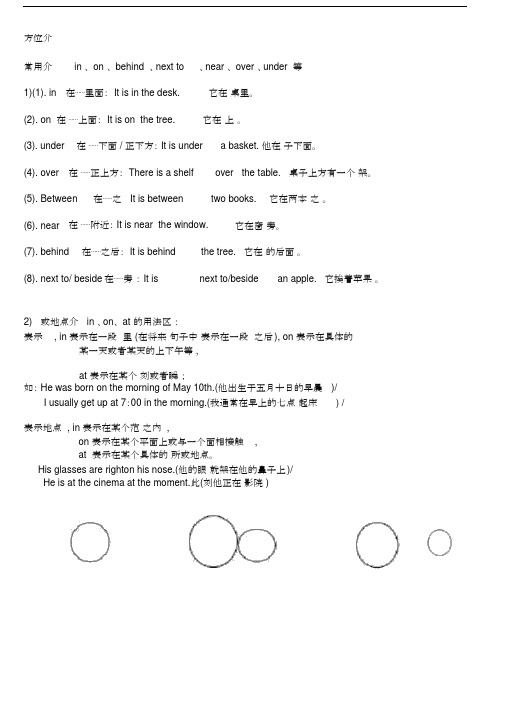
方位介常用介in 、 on 、 behind 、next to 、near 、 over 、under 等1)(1). in 在⋯⋯里面: It is in the desk. 它在桌里。
(2). on 在⋯⋯上面: It is on the tree. 它在上。
(3). under 在⋯⋯下面 / 正下方: It is under a basket. 他在子下面。
(4). over 在⋯⋯正上方: There is a shelf over the table. 桌子上方有一个架。
(5). Between 在⋯⋯之 It is between two books. 它在两本之。
(6). near 在⋯⋯附近: It is near the window. 它在窗旁。
(7). behind 在⋯⋯之后: It is behind the tree. 它在的后面。
(8). next to/ beside在⋯⋯旁:It is next to/beside an apple. 它挨着苹果。
2)或地点介 in 、on、 at 的用法区:表示 , in 表示在一段里 (在将来句子中表示在一段之后), on 表示在具体的某一天或者某天的上下午等 ,at 表示在某个刻或者瞬;如: He was born on the morning of May 10th.(他出生于五月十日的早晨)/I usually get up at 7:00 in the morning.(我通常在早上的七点起床) /表示地点 , in 表示在某个范之内 ,on 表示在某个平面上或与一个面相接触,at 表示在某个具体的所或地点。
His glasses are righton his nose.(他的眼就架在他的鼻子上)/He is at the cinema at the moment.此(刻他正在影院 )B A B A B AB 在 A 里——用in A 和B 相(接壤)——用on A 和B 不相(不接壤)——用to3) in front of “在⋯之前”(范外)in the front of 表示“在⋯的前部”(范内)演1. The United States is ____ the south of Canada and ___ the east of Japan.A. to; inB. on; toC. in; besideD. at; on2 . Japan lies____ the east of China.A. on B/ to C. in D. with3. Jiangsu is___ the east of China, but Japan is ___ the east of China.A. to; inB. in; to .C. on; toD. to; on4.There are some trees_________ the classroomThere is a blackboard ____________ the classroom.5.—Look, there are many apples ______ the tree.—Yes. And a boy is picking apples ______ the tree now.A. in; onB. on; inC. in; inD. on; on6.When did you arrive ______school this morning?A. inB. atC. toD. with。
常用方位介词
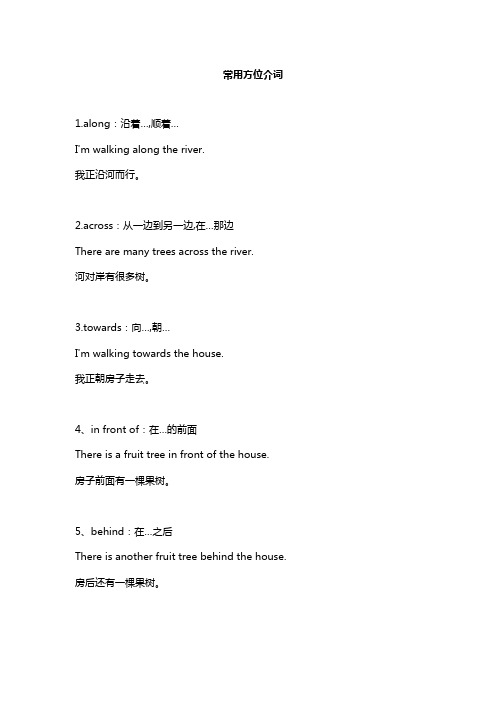
常用方位介词1.along:沿着…,顺着…I'm walking along the river.我正沿河而行。
2.across:从一边到另一边,在…那边There are many trees across the river.河对岸有很多树。
3.towards:向…,朝…I'm walking towards the house.我正朝房子走去。
4、in front of:在…的前面There is a fruit tree in front of the house.房子前面有一棵果树。
5、behind:在…之后There is another fruit tree behind the house. 房后还有一棵果树。
6、into:到…里,进入内部I want to go into the house.我想走进房子。
7、inside:在…的里面,在…内部I am inside the house now.我正在房子里。
8、outside:在…外面Now I am outside the house.我现在来到房外。
9、in:在…里,表示在含有空间感的范围或物体之中There is nobody in the house.房子里面没有人。
10、above:在…之上,表示高于,不是垂直的There are lots of apples above my head.我的头顶上有很多苹果。
11、under:在…正下方,强调垂直在…之下I want to have a rest under the tree.我想在树下休息一会儿。
12、off:从…脱落,从…掉下on:在…之上,与…表面相接触An apple falls off the tree and hits me on the head. 一只苹果从树上掉下砸在我的头上。
20个英语方位介词
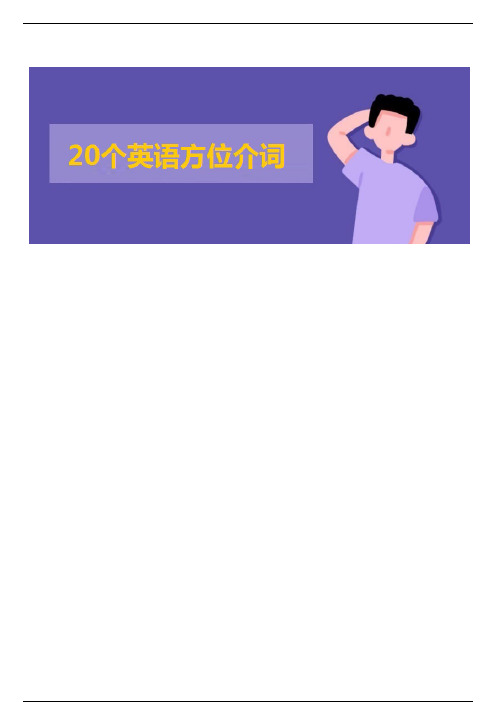
20个英语方位方位介词:in、on、over、under、above、below、by、beside、near 、next to、behind、before、outside、from、among、between等等。
—— 20个英语方位介词及释义 ——方位介词(1):in释义:在……之内例句:The students are reading in the classroom.学生们在教室里读书。
方位介词(2):on释义:在……上面例句:The boat is on the river.那条船在河上。
方位介词(3):over释义:在……(正)上方例句:There are several bridges over the river. 河上有好几座桥。
方位介词(4):under释义:在……(正)下方例句:The boat sailed under the bridge.船在桥下行驶。
方位介词(5):above释义:在……上方例句:The plane flew above the clouds.飞机在云上飞行。
方位介词(6):below释义:在……下方例句:The sun sinks below the horizon.太阳沉没在地平线下。
方位介词(7):by释义:在……旁边例句:Our house is by the river.我们的房子在河边。
方位介词(8):beside释义:Come and sit beside me.过来坐在我旁边。
方位介词(9):near释义:在……附近例句:Idon’t need a car becauseIlive nearthecity centre .我不需要汽车,因为我住在靠近市中心方位介词(10):next to释义:紧挨……例句:My best friend sits next to me in class.上课时我最好的朋友坐在我的旁边。
方位介词(11):behind释义:在……后面例句:Olive hid behind a tree.奥列弗藏在一棵树后面。
常用方位介词和短语

常用方位介词和短语常用方位介词与短语【概念引入】介词后面可以跟名词与代词做宾语,构成介词短语。
今天我们主要学习一下用来表示方位的介词与介词短语。
【用法讲解】1、on介词on表示“在某物之上”的意思,它通常表示一个物体在另一个物体之表面上面。
两者之间有接触。
例如:Your book is on the desk、您的书在课桌上面。
There is a ball on the floor、地板上有个球。
拓展:above 与over的区别on指的有接触面的上面,但就是over与above都就是没有接触面的上面。
over“在……正上方”,与under相对。
例如:There is a bridge over the river、河上有一座桥。
The picture is hanging over the blackboard、那张图挂在黑板的正上方。
above只表示“在……上方或位置高出……”,不一定就是正上方,与below相对。
例如:A plane flew above our heads、一架飞机从我们头上飞过。
The Turners live above us、特纳一家人住在我们的上面。
2、in介词in表示“在某物的里面”,它通常表示一个物体在另外一个物体的内部、中间或者在某个范围之内。
例如:Your pen is in the pencil case、您的钢笔在铅笔盒里面。
She is the tallest in her class、她就是她们班最高的。
3、under介词under表示“在某物的下面”,它通常表示一个物体在另外一个物体的垂直正下面,两者之间没有接触。
例如:My bike is under the tree、我的自行车在树的下面。
The shoes are under the chair、鞋在椅子的下面。
拓展:under与below 的区别under表示“在……之下”,通常表示位置处于正下方,与介词over“在……上方”相对应。
初中英语方位介词
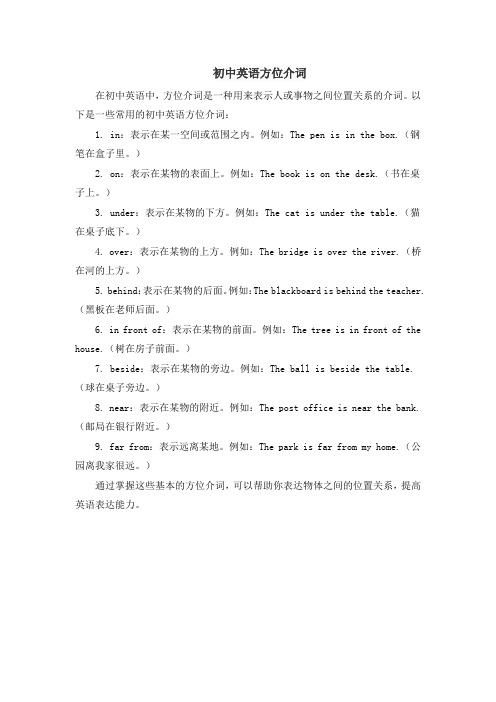
初中英语方位介词在初中英语中,方位介词是一种用来表示人或事物之间位置关系的介词。
以下是一些常用的初中英语方位介词:1. in:表示在某一空间或范围之内。
例如:The pen is in the box.(钢笔在盒子里。
)2. on:表示在某物的表面上。
例如:The book is on the desk.(书在桌子上。
)3. under:表示在某物的下方。
例如:The cat is under the table.(猫在桌子底下。
)4. over:表示在某物的上方。
例如:The bridge is over the river.(桥在河的上方。
)5. behind:表示在某物的后面。
例如:The blackboard is behind the teacher.(黑板在老师后面。
)6. in front of:表示在某物的前面。
例如:The tree is in front of the house.(树在房子前面。
)7. beside:表示在某物的旁边。
例如:The ball is beside the table.(球在桌子旁边。
)8. near:表示在某物的附近。
例如:The post office is near the bank.(邮局在银行附近。
)9. far from:表示远离某地。
例如:The park is far from my home.(公园离我家很远。
)通过掌握这些基本的方位介词,可以帮助你表达物体之间的位置关系,提高英语表达能力。
英语表示方位的介词

英语表示方位的介词一、常见表示方位的介词1. in(在……里面)- 表示在一个封闭的空间内部。
例如:- There are some books in the box.(盒子里有一些书。
)- The cat is in the room.(猫在房间里。
)2. on(在……上面,与表面接触)- 用于描述物体在一个平面的表面上。
例如:- The cup is on the table.(杯子在桌子上。
)- There is a picture on the wall.(墙上有一幅画。
这里的画是附着在墙的表面上的)3. under(在……下面)- 表示在某物的正下方。
例如:- The ball is under the chair.(球在椅子下面。
)- My shoes are under the bed.(我的鞋子在床下面。
)4. above(在……上方,不一定垂直,不接触)- 强调在某个物体的上方,但不一定是正上方,而且两者不接触。
例如:- The plane is flying above the clouds.(飞机正在云层上方飞行。
)- There is a lamp above the desk.(书桌上方有一盏灯。
)5. below(在……下方,不一定垂直,不接触)- 和above相对,指在某个物体的下方,但不一定是正下方,两者不接触。
例如:- The temperature below the mountain is higher.(山下的温度更高。
) - The fish are swimming below the surface of the water.(鱼在水面下方游动。
)6. beside(在……旁边)- 表示在某物的近旁。
例如:- The boy is standing beside his mother.(男孩站在他妈妈旁边。
)- There is a tree beside the house.(房子旁边有一棵树。
仁爱版英语七年级下册Unit6 Topic3 常见方位介词及词组汇总

常见方位介词及词组汇总一、方位介词1. at表示“在……处”,一般指较小的比较具体的地点。
He isn’t at school. He is at home.2. in表示“在……内部;在……里面”的意思。
What is in the box? 盒子里有什么?3. on表示“在某物的上面”,但两者互相接触。
My books are on that table. 我的书在那张桌子上。
4.above在……上方。
指两者既不垂直也不接触(反义词below)。
Many birds are flying above the woods.许多鸟在树林上飞。
5. under表示“在某物垂直的正下方”,两者之间不接触。
My cat is under my chair. 我的猫在我的椅子下。
6. behind表示“在某物体的后面”。
The boy is behind the door. 男孩在门后。
7 in front of表示“在……的前面”,正好与behind相反。
如:There are some big trees in front of our classroom. 我们教室前面有几棵大树。
8. near表示“在某物体的附近”,意为“接近、靠近”。
The ball is near the door. 球在门旁边。
介词in, on, under, behind是表示静态位置的介词。
二、常见方位介词短语(一)、由介词in构成的方位介词短语1、in the front 在前面2、in the front row 在前排3、in the back row 在后排4、in the third row 在第三排5、in front of... 在……前面(范围之外)6、in the front of... 在……前部(范围之内)7、in the middle在中间8、in the street在街上9、in the middle of...在……中间10、in the tree在树上(指飞鸟等外来物)(二)、由介词at构成的方位介词短语1、at the front of...在……所在范围的前一部分2、at the back of...在……所在范围的后一部分3、at the foot of...在……脚下4、at the top of...在……顶部5、at the end of...在……尽头6、at the head of...在……前头7、at the (school) gate在(校)门口8、at the station 在车站9、at No.2 Chang’an Road在长安路2号10、at my uncle’s 在我叔叔家11、at home在家12、at the doctor’s在医务室/在诊所(三)、由介词on构成的方位介词短语1、on the right/left在右(左)边2、on one’s right/left在某人的右(左)边3、on the desk/table在课桌/桌上4、on the right-hand/left-hand side在右/左手边5、on the blackboard在黑板上6、on/in the wall在墙上/里7、on the paper在纸上8、on the tree在树上(指树上长的,结的东西)三、其它介词构成的方位介词短语1、next to靠近/贴近2、beside the desk在课桌旁3、behind the door在门后4、under the bed在床下5、near the window靠近窗户6、outside the gate在门外。
英语方位介词东南西北
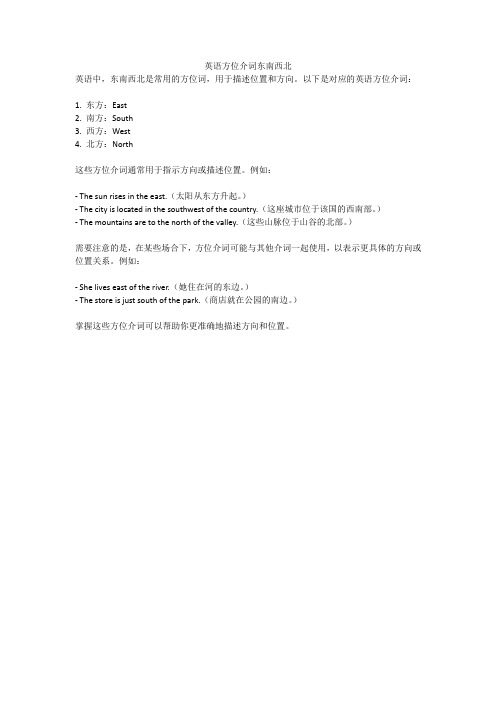
英语方位介词东南西北
英语中,东南西北是常用的方位词,用于描述位置和方向。
以下是对应的英语方位介词:
1. 东方:East
2. 南方:South
3. 西方:West
4. 北方:North
这些方位介词通常用于指示方向或描述位置。
例如:
- The sun rises in the east.(太阳从东方升起。
)
- The city is located in the southwest of the country.(这座城市位于该国的西南部。
)
- The mountains are to the north of the valley.(这些山脉位于山谷的北部。
)
需要注意的是,在某些场合下,方位介词可能与其他介词一起使用,以表示更具体的方向或位置关系。
例如:
- She lives east of the river.(她住在河的东边。
)
- The store is just south of the park.(商店就在公园的南边。
)
掌握这些方位介词可以帮助你更准确地描述方向和位置。
外研版英语七年级上册Module 3 方位介词短语大集合

方位介词短语大集合一、由介词in构成的方位介词短语:1. in the front 在前面2. in the front row在前排3. in the back row 在后排4. in the third row 在第三排5. in front of …在……前面(范围之外)6. in the front of… 在……前部(范围之内)7. in t he middle在中间8. in the middle of…在……中间9. in the street 在街上二、由介词at构成的方位介词短语:1. at the font of…在……所在范围的前一部位2. at the back of… 在……所在范围的后一部位3. at the foot of…在……脚下4. at the top of…在……顶部5. at the end of…在……尽头6. at the head of…在……前头7. at the (school) gate 在(校)门口8. at the station 在车站9. at No. 2 Changan Road 在长安路2号10. at my uncle's 在我叔叔家11. at home 在家12. at the doctor's在医务室/在诊所三、由介词on构成的方位介词短语:1. on the right / left 在右(左)边2. on one's right / left 在某人的右(左)边3. on the desk / table 在课桌/桌上4. o n the right - hand / left - hand side 在右/左手边5. on the blackboard 在黑板上6. o n / in the wall 在墙上/里7. on the paper 在纸上四、由其它介词构成的方位介词短语:1. next to 靠近/贴近2. beside the desk 在课桌旁3. behind the doo r 在门后4. under the bed 在床下5. near the window 靠近窗户6. outside the gate 在门外7. between A and B 在A和B之间8. among the hills 在山中。
介词in,on,to,off-方位-表达法
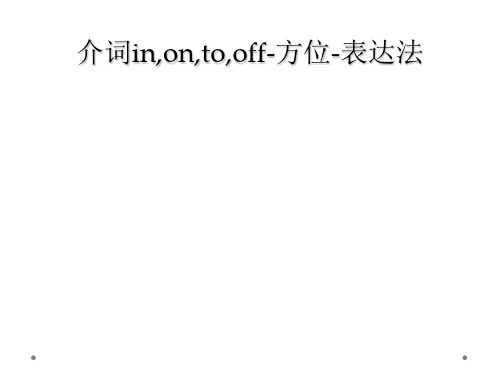
五.介词off表方位
off,表示“离(某地)不远;在…附近或离……不远的海 上”。 eg. 1.The boat was anchored off the northern coast.
这艘船停泊在离海岸北部不远的地方。 2.Lily lives in a flat just off Park Avenue.
四.介词to表方位用法2
把河流、山脉、铁路等事物当做两地的分界线或基点,而且不 说明河流、山脉、铁路等是属于哪一方,通常使用介词 to,译 为“以……(方向)”。此外,表示一个地方离另一个地方有多远, 也用 to。 eg. nd to the east of the Urals is called Asia; land to the
west, Europe. 乌拉尔山脉以东的陆地称为亚洲;以西的陆地称为欧洲。 2.The village lies to the south of the hill. 那座村庄在山的南面。 3.The little town lies about one hundred miles to the west of Guilin. 那座小城镇位于桂林以西约一百公里远的地方。
eg. 1.We are sailing in the direction of east by north. 我们正朝着正东偏北方向航行。
2.The island lies south by east from here. 那个岛位于此地的正南偏东方向。
仿句练习
1.这艘轮船将向西偏北方向航行。 The steamer will go west by north.
Beijing. 十三陵位于北京西北 50公里处。 Tianjin is situated l20 km southeast of Beijing. 天津位于北京东南120公里处。
方位介词初中英语

表示位置的介词有:at, in, by, near, between, under表示方向的介词有: to, into, out, out of, across, along, through1 at表示在某地点,强调在某个位置点例:I met her at the school gate this morning. 我今天早上在校门口遇见了她。
at也用于街道号码前例:She lives at 78 Nanjing Road. 她住在南京路78号。
She lives on Nanjing Road. 她住在南京路。
(街道前无号码时用on)She lives in Queen Street. 她住在女王街。
(住在某大街用in)2 in表示“在某区域内,在一个空间的内部,在……里面”例:She was born in Nanjing. 她生于南京。
提示:两个地名连用时,小的用at,大的用in.例:He arrived at London in England last week. 他上周到达英国伦敦。
They will meet at Washington in America. 他们将在美国华盛顿会面。
3 on表示“在……上”,并与之相接触例:He put the dictionary on the desk. 他把词典放在桌子上。
比较英国英语和美国英语的不同介词用法:在路上 on the road (美)in the road (英)在街上 on the street (美)in the street (英)在周末 on the weekend (美)at the weekend (英)在这个队 on the team (美)in the team (英)4 under和below表示“在……的正下方”,指垂直上下。
below表示“低于某物”,只表示位置低于,但不是在正下方。
例:There is a chair under the table. 桌子下面有一把椅子。
初一英语方位介词

初一英语方位介词一、方位介词1、at表示\"在、、、、、、处\",一般指较小的比较具体的地点。
He isnt at school、 He is at home、2、 in表示\"在、、、、、、内部;在、、、、、、里面\"的意思。
W hat is in the box? 盒子里有什么?3、 on表示\"在某物的上面\",但两者互相接触。
My books are on that table、我的书在那张桌子上。
4、above在、、、、上方。
指两者既不垂直也不接触(反义词below)Many birds are flying above the woods、许多鸟在树林上飞。
5、 under表示"在某物垂直的正下方",两者之间不接触。
My cat is under my chair、我的猫在我的椅子下。
6、 behind表示"在某物体的后面"。
T he boy is behind the door、男孩在门后。
7 in front of表示\"在、、、、、、的前面\",正好与behind相反。
如:There are some big trees in front of our classroom、我们教室前面有几棵大树。
8、 near表示\"在某物体的附近\",意为"接近、靠近。
T he ball is near the door、球在门旁边。
介词in, on, under, behind是表示静态位置的介词。
二、常见方位介词短语(一)、由介词in构成的方位介词短语1、in the front 在前面2、in the front row 在前排3、in the back row 在后排4、in the third row 在第三排5、in front of、、、在、、、前面(范围之外)6、in the front of、、、在、、、前部(范围之内)7、in the middle在中间8、in the street在街上9、in the middle of、、、在中间10、in the tree在树上(指飞鸟等外来物)(二)、由介词at构成的方位介词短语1、at the front of、、、在、、、所在范围的前一部分2、at the back of、、、在、、、所在范围的后一部分3、at the foot of、、、在、、、脚下4、at the top of、、、在、、、顶部5、at the end of、、、在、、、尽头6、at the head of、、、在、、、前头7、at the(school)gate在(校)门口8、at the station 在车站9、at No、2 Chang’an Road在长安路2号10、at my uncle’s 在我叔叔家11、at home在家12、at the doctor’s在医务室/在诊所(三)、由介词on构成的方位介词短语1、on the right/left在右(左)边2、on one’s right/left在某人的右(左)边3、on the desk/table在课桌/桌上4、on the right-hand/left-hand side在右/左手边5、on the blackboard在黑板上6、on/in the wall在墙上/里7、on the paper在纸上8、on the tree在树上(指树上长的,结的东西)三、其它介词构成的方位介词短语1、next to靠近/贴近2、beside the desk在课桌旁3、behind the door在门后4、under the bed在床下5、near the window靠近窗户6、outside the gate在门外。
20个常用英语表方位介词
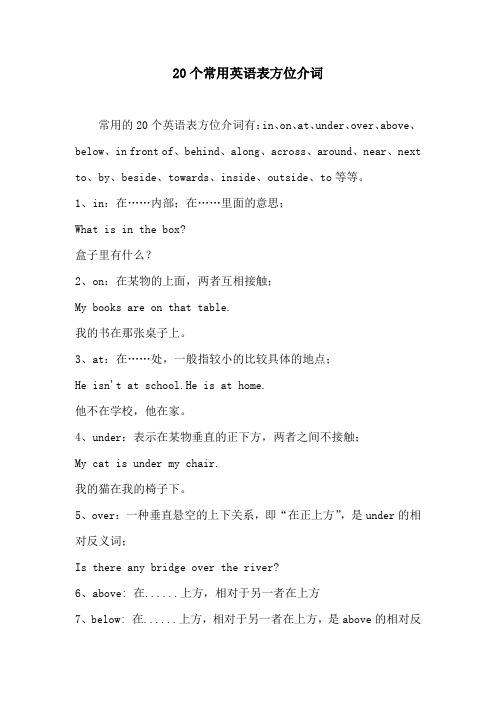
20个常用英语表方位介词常用的20个英语表方位介词有:in、on、at、under、over、above、below、in front of、behind、along、across、around、near、next to、by、beside、towards、inside、outside、to等等。
1、in:在……内部;在……里面的意思;What is in the box?盒子里有什么?2、on:在某物的上面,两者互相接触;My books are on that table.我的书在那张桌子上。
3、at:在……处,一般指较小的比较具体的地点;He isn't at school.He is at home.他不在学校,他在家。
4、under:表示在某物垂直的正下方,两者之间不接触;My cat is under my chair.我的猫在我的椅子下。
5、over:一种垂直悬空的上下关系,即“在正上方”,是under的相对反义词;Is there any bridge over the river?6、above: 在......上方,相对于另一者在上方7、below: 在......上方,相对于另一者在上方,是above的相对反义词;8、in front of:在……的前面,正好与behind相反;There are some big trees in front of our classroom. 我们教室前面有几棵大树。
9、behind:在某物体的后面。
The broom is behind the door.笤帚在门后。
10、along:沿着……,顺着……I'm walking along the river.我正沿河而行。
11、across:从一边到另一边,在……那边。
There are many trees across the river.河对岸有很多树。
12、around:“围绕,绕着”The house is built around a central courtyard.这房子是围绕着中央的庭院而建的。
初中英语中考复习词汇短语汇总(方位介词+动词短语+生活词汇+房子词汇)

初中英语词汇短语一、方位介词Where is the car?汽车在哪?The car is in front of the garage.汽车在车库前面in front of 在...前面(范围外)in the front of 在...物体内部的前面behind 在...后面in 在...里面on 在...上面above 在...上方below 在...下方over 在...正上方under 在...正下方between 在两者中间among 在...之中(三者以上)next to 紧邻toward 朝;向on top of在...之上near 在...附近about 大约around 在...周围past 经过along 沿着into 到...里面out of 在...之外onto 到...之上off 从...离开up 向上down 向下through (内部)穿过across (表面)穿过二、动词短语break down 出故障(broke 过去式) end up 最终pick up拿;接人;学会;捡起hold up 维持give out 无法继续使用rely on 依赖wear out疲惫不堪put aside 储存keep up with 跟上fall behind 落后catch up on 赶上give up 放弃focus on 集中精力come along 过来fly out 通过飞机离开某地freak out害怕get over 克服run away 逃跑step out 走出去hold back 克制miss out 错过take on 接受;承担go for it 加油open up 敞开split up 分开break off 中断go out 外出get back together 复合let sb.down 让某人失望keep away from 保持距离fall apart 破碎;崩溃turn out 结果是;证明是revolve around 以...为中心stand out 突出;显眼blend into 融入show off 炫耀look down on 鄙视laugh at 嘲笑measure up to 达到标准;符合期望get into 陷入fight over 为...争吵get down on对...表示不满give in屈服;让步put up with 忍受put on 穿上;上演;增加grow apart 渐行渐远bring together 集合;使团结win over 说服;战胜fall for 迷恋ask sb.out 邀请某人出去1bring about 导致start out 开始end up 结束sit around 闲坐wait around 等待stand for 忍耐move on 继续前进;从...中走出stick around 逗留put sb.down 令某人失望go against 违背bring up 教育;培养grow up 长大knock sb.down 使某人倒下lie ahead 在前方boost up鼓励某人rely on 依赖open up 敞开心扉blow away 使惊叹三、日常生活词汇wake up 醒来wash your face 洗脸take a shower 洗个淋浴brush your teeth 刷牙get dressed 穿上衣服brush your hair 刷你的头发do your hair 做你的头发make your bed整理你的床put on makeup 化妆have breakfast吃早餐go to school 去上学drive to work 开车去工作work 工作study 学习wash your hands 洗手have lunch 吃午餐leave school 离开学校get home 到家take a nap 小睡一下have a snack 吃点心do homework 做家庭作业play computer games 玩电脑游戏read a book 阅读一本书play with peers 和同伴玩耍ride a bike 骑单车go shopping 去购物listen to music 听音乐exercise 锻炼mop the floor 拖地vaccum 用真空吸尘器打扫take out the trash 把垃圾带出去water the lawn 给草坪浇水go for a walk 去散步watch TV 看电视do the laundry 洗衣hang the clothes 挂衣服iron the clothes 熨烫衣服do the dishes 洗碗do the dusting做除尘make dinner 做晚饭take a bath 泡澡dry your hair 吹头发go to bed 上床睡觉四、房子词汇房子外部fence 围栏garden花园balcony 阳台chimney 烟囱windows 窗户wall 墙swimming pool 游泳池light 灯door 门attic 阁楼path 小路drainpipe 排水管shutter 百叶窗garage 车库driveway 车道porch 走廊stiars 楼梯basement 地下室roof房顶房子内部attic 阁楼bedroom 卧室living room 客厅laundry room 洗衣房bathroom 浴室study 学习2hallway 走廊dining room饭厅Kitchen 厨房客厅wall 墙floor lamp 落地灯sofa 沙发floor 地板curtains 窗帘window 窗户cushion坐垫table 桌子carpet 地毯armchair 扶手椅picture画chandelier 吊灯air conditioner 空调television 电视television cabinet 电视柜remote control 遥控speaker 扬声器clock 钟fireplace 壁炉bookshelf 书架卧室poster 壁纸lamp台灯pollows 枕头blanket 毛毯alarm clock 闹钟bedside table 床头柜chest of drawers 抽屉柜wardrobe 衣柜dressing table 梳妆台rug 小地毯shelf 柜子bed 床浴室shower淋浴soap 肥皂mirror 镜子sink水槽towel 毛巾light 灯plunger柱塞toilet brush 马桶刷cabinet柜子toilet paper 厕纸toothpaste 牙膏toothbrush 牙刷shampoo 洗发水hair dryer 吹风机comb 梳子hairbrush 发刷sponge 海绵bathtub 浴缸bath mat 浴垫scale 秤toilet厕所洗衣房washing machine 洗衣机laundry 洗衣物laundry basket 洗衣篮ironing board 熨衣板iron 熨斗dustpan 簸箕vacuum cleaner 吸尘器broom 扫把mop 拖把boiler 烧水装置书房drawer 抽屉chair 椅子keyboard 键盘calendar 日历corkboard 公告板monitor 显示器shelf 架子books 书printer 打印机clipboard剪贴板desk lamp 台灯laptop 笔记本电脑folder 文件夹file racks 文件架厨房dishes 盘子sink 水槽pot锅chopping board 砧板range hood抽油烟机kettle 水壶stove 炉子oven 烤箱knives stand刀架counter 柜台blender 搅拌机chair 椅子table 桌子cup 杯子cabinet 柜子refrigerator 冰箱microwave 微波炉dishwasher 洗碗机napkin餐巾纸glass 玻璃杯fork 叉子plate 盘子knife 刀spoon勺子salt shaker 盐瓶glass hanger 挂杯架pan 平底锅3。
七年级英语语法介词
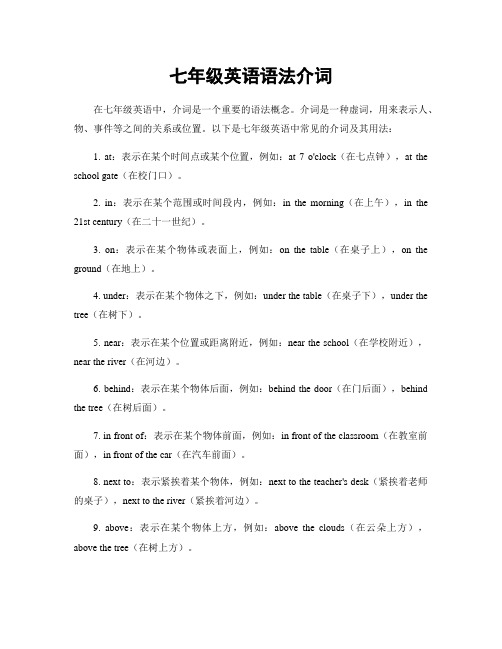
七年级英语语法介词在七年级英语中,介词是一个重要的语法概念。
介词是一种虚词,用来表示人、物、事件等之间的关系或位置。
以下是七年级英语中常见的介词及其用法:1. at:表示在某个时间点或某个位置,例如:at 7 o'clock(在七点钟),at the school gate(在校门口)。
2. in:表示在某个范围或时间段内,例如:in the morning(在上午),in the 21st century(在二十一世纪)。
3. on:表示在某个物体或表面上,例如:on the table(在桌子上),on the ground(在地上)。
4. under:表示在某个物体之下,例如:under the table(在桌子下),under the tree(在树下)。
5. near:表示在某个位置或距离附近,例如:near the school(在学校附近),near the river(在河边)。
6. behind:表示在某个物体后面,例如:behind the door(在门后面),behind the tree(在树后面)。
7. in front of:表示在某个物体前面,例如:in front of the classroom(在教室前面),in front of the car(在汽车前面)。
8. next to:表示紧挨着某个物体,例如:next to the teacher's desk(紧挨着老师的桌子),next to the river(紧挨着河边)。
9. above:表示在某个物体上方,例如:above the clouds(在云朵上方),above the tree(在树上方)。
10. below:表示在某个物体下方,例如:below the ground(在地上方),below the surface(在水面下方)。
英语东南西北方位介词用法大全
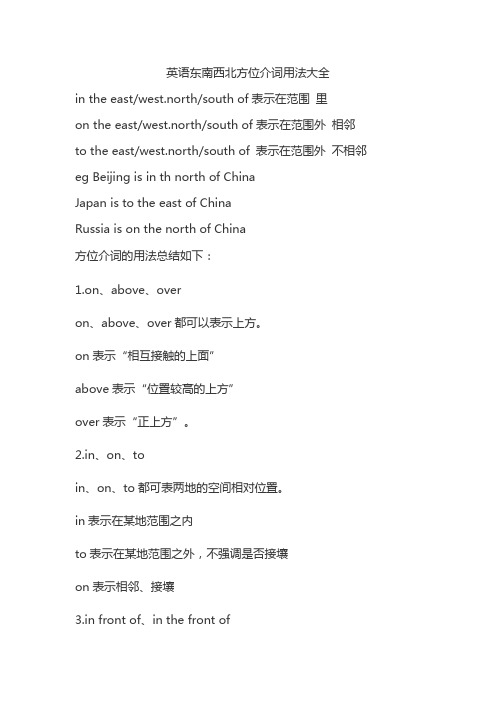
英语东南西北方位介词用法大全
in the east/west.north/south of表示在范围里
on the east/west.north/south of表示在范围外相邻to the east/west.north/south of 表示在范围外不相邻eg Beijing is in th north of China
Japan is to the east of China
Russia is on the north of China
方位介词的用法总结如下:
1.on、above、over
on、above、over都可以表示上方。
on表示“相互接触的上面”
above表示“位置较高的上方”
over表示“正上方”。
2.in、on、to
in、on、to都可表两地的空间相对位置。
in表示在某地范围之内
to表示在某地范围之外,不强调是否接壤
on表示相邻、接壤
3.in front of、in the front of
in front of表示“在......外部的前面”
in the front of表示“在......内部的前面”。
4.near、by、beside
near表示“在附近”
by和beside表示“在旁边”,比near表示的距离更近一些。
5.between、among
between表示“在二者之间”
among表示“在多者之间”。
需要注意的是,among通常后接抽象的人和事物,若需接具体的人和事物时,即使表示多者之间,也应当用between,此时可以理解为多者之中的任意二者之间。
七年级语法常用方位介词和短语

七年级语法常用方位介词和短语↑常用方位介词和短语1概念引入本单元学习介词+定冠词the+名词构成介词短语的用法,介词后面可以跟名词和代词做宾语,构成介词短语。
今天我们主要学习一下用来表示方位的介词和介词短语。
2用法讲解1. on介词on表示“在某物之上”的意思,它通常表示一个物体在另一个物体之表面上面。
两者之间有接触。
例如:Your book is on the desk. 你的书在课桌上面。
There is a ball on the floor. 地板上有个球。
拓展:above 和 over的区别on指的有接触面的上面,但是over和above都是没有接触面的上面。
over“在……正上方”,与under相对。
例如:There is a bridge over the river. 河上有一座桥。
The picture is hanging over the blackboard.那张图挂在黑板的正上方。
above只表示“在……上方或位置高出……”,不一定是正上方,与below相对。
例如:A plane flew above our heads. 一架飞机从我们头上飞过。
The Turners live above us. 特纳一家人住在我们的上面。
2. in介词in表示“在某物的里面”,它通常表示一个物体在另外一个物体的内部、中间或者在某个范围之内。
例如:Your pen is in the pencil case. 你的钢笔在铅笔盒里面。
She is the tallest in her class. 她是她们班最高的。
3. under介词under表示“在某物的下面”,它通常表示一个物体在另外一个物体的垂直正下面,两者之间没有接触。
例如:My bike is under the tree. 我的自行车在树的下面。
The shoes are under the chair. 鞋在椅子的下面。
初中语法方位介词)

二、表示地点的介词in、on、behind、next to、near、over、under<1>. in在……里面:The pencil is in the desk. 铅笔在课桌里.<2>. on在……上面:There are some apple on the tree. 树上有些苹果.<3>. under在……下面/正下方:What's under your desk? 你书桌底下是什么?<4>.over在……正上方:There is a shelf over the table. 桌子上方有一个书架.<5>. above 在……斜上方:Raise your arms above your head.<6>. below 在……斜下方:Her skirt came below her knees.<7>.behind在……之后:There is a bike behind the tree. 树后有一辆自行车.<8>.next to在……旁边:There is a café n ext to the barber's. 理发店隔壁是一家咖啡馆.<9>.near在……附近:My bed is near the window. 我的床在窗户旁.<10>.by 在……旁:He was sitting by the window .第一组:over, above和on的用法1〕over指在…的正上方,表示垂直在上.如:There is a lamp over the desk.2>above指在上方,属于斜上方.如:Raise your arms above your head.3>on指在上面,表示两物体接触.如:There is a cup on the table.第二组:under / below的用法:1> under在……下面/正下方:What's under your desk?2> below 在……斜下方:Her skirt came below her knees.练习:< > 1 The boat is passing___ the bridge.A. throughB. belowC. underD. across< > 2 Two planes are flying___ the city.A. throughB. over ,C. on , D, below< > 3 We can see a river running to the east____ the hill.A. underB. belowC. overD. on< > 4 Do you see the kite ___ the building.A. overB. crossC. onD. aboveC B B D第三组:in 和on表示"在……上"1,门一类——镶嵌在墙里的,用in,字画一类——挂在墙面上的,用on< > 1 He put up a map ___ the back wall because there was a hole ___ it.A. on; onB. at; inC. on; inD. on; at< > 2 There is a door___ the wall.A. onB. toC. ofD.in< > 3 Any man ___ eyes______ his head can see that he's exactly like arope.A. with; on B. with; in C. on; with D. in; with2,鸟一类落在树上的,用in;苹果一类长在树上的,用on< > 1 There are some birds singing___ the trees.A. inB. onC. atD. from< > 2 There are so many apples___ that tree.A. in B, on C. at D. from第四组:in /on/ to表示"接壤"B A B A B AB 在A里——用in A和B相邻〔接壤〕——用on A和B 不相邻〔不接壤〕——用to< > 1 The United States is ____ the south of Canada and ___ the east of Japan.A. to; inB. on; toC. in; besideD. at; on< > 2 The man stood____the window, watching the boys playing outside.A. inB. byC. withD. to< > 3 Japan lies____ the east of China.A. on B/ to C. in D. withB B BB第五组:at, in表示"在……"1>at表示较小的地点.如:at the bus stop, at home2>in表示较大的地点.如:in China, in the world<> 1 Uncle Wang arrived____ No. 14 Middle School half an hour ago.A.atB. in Cto D. /< > 2 My uncle lives ____ 88 Beijing Street.A. toB. ofC. atD. on< > 3 They are waiting ___ a bus ___ the bus stop.A. for; inB. on; atC. with; atD. for; at第六组:in front of 和in the front of1>in front of表示"在…之前"〔范围外〕.如:There are some trees in front of the classroom.2>in the front of 表示"在…的前部"〔范围内〕如:There is a blackboard in the front of the classroom.第七组:in / intoin表示"在……里面",强调静态;into表示"去……里面",强调动态.第八组:through / across通过,穿过across表示横过,即从物体表面通过,与on有关,为二维through穿过,即从物体内部穿过,与in有关,为三维.< > 1 Is the street too narrow for the bus to go ___?A. throughB. acrossC. onD. in< > 2 A mother camel was walking ___ her son ___ the desert.A. without; alongB. with; throughC. next to; passD. beside; through< > 3 The river runs____ the city.A. acrossB. throughC. overD. from < > 4 It took us over an hour to walk____ this street.A. fromB. throughC. overD. acrossA B BB练习1:< > 1 Tom sits____the classroom while John sits____the room.A. in front of; at back ofB. in the front of; at the back ofC. in front of; at the back ofD. in the front of; at back of< > 2 Lucy sits____ the third row, ____Jim‘s left.A. on; onB. in; atC. at; inD. in; on< > 3 Jiangsu is___ the east of China, but Japan is ___ the east of China.A. to; inB. in; to .C. on; toD. to; on< > 4Don‘t read ____ the sun. It‘s bad ___ your eyes.A. in; toB. under; forC. with; toD. in; on< > 5The woman____ a blue dress is my teacher.A. inB. onC. ofD. at< > 6 ___ research ___ the universe scientists have put a lot of information ___ puters.A. With; over; atB. On; at; toC. In; about; intoD. For; with; through< > 7When a piece of ice is taken ____ a warm room, it gets smaller and smalleruntil ___ the end it disappears pletely. A. in; in B. out of; at C. into; in D. to; by < > 8 A woman fell ___ the boat ___ the water.A. off; intoB. at; belowC. down; underD. away; in练习2:1. We traveled overnight to Paris and arrived _______ 5 o’clock ______ the morning.A. on; inB. at; inC. at; onD. in; on2. Jack has studied Chinese in this school _______ the year of 2000.A. sinceB. inC. onD. by3. Hong Kong is ______ the south of China, and Macao is ______ the west of Hong Kong.A. in; toB. to; toC. to; inD. in; in4. Japan lies ______ the east of China.A. toB. inC. aboutD. at5. I won’t believe that the five-year-old boy can read five thousand words ______ I have tested him myself.A. afterB. whenC. ifD. until6. The book was so interesting that he had read it for three hours ______ he realized it.A. whenB. untilC. afterD. before7. Look ___the map ___China ___the wall, please.A after, of, inB at, of, inC after, in, onD at, of, on8. - Please remember to e to my birthday party.- I see. I'll e ___Saturday evening.A inB atC onD for9. They will have a maths test ___two daysA forB atC inD after10. My brother joined the army ___A 1989, MarchB in March, 1989C March, 1989D 1989, in March11.We had our breakfast ___a quarter ___sevenA /, toB in, toC at, toD on, to12. It's good manners to wait ___lineA inB onC atD with13. How many English words had you learnt ___last term?A by the end ofB at the end ofC to the end ofD till the end of14. I was born ___the night ___September 15, 1978A in, on Bat, on Cat, in Don, of15. It's a bad manner to laugh ___people when they are ___troubleA over, in Bat, in C in, at D at, for16. The people's Republic of China was founded ___1949A withB onC sinceD in17. He arrived _____ Guangzhou ____ noon.A. in; inB. to; atC. in; atD. at; in18. They work _____ a small farm _____ a river.A. on; byB. at; onC. by; onD. in; in19. --When will Mr Black e to Beijing?-- ____ September 5th.A. OnB. ToC.AtD. In20. ____ the night before Christmas Day, parents fill their children’s stockings with small presents.A. OfB. AtC.ToD. On答案:练习1:1-5 B D B A A 6-10 CCA练习2:1-5 BAAAD 6-10 DDCCB 11-15 CAADB 16-20 DCAAD。
- 1、下载文档前请自行甄别文档内容的完整性,平台不提供额外的编辑、内容补充、找答案等附加服务。
- 2、"仅部分预览"的文档,不可在线预览部分如存在完整性等问题,可反馈申请退款(可完整预览的文档不适用该条件!)。
- 3、如文档侵犯您的权益,请联系客服反馈,我们会尽快为您处理(人工客服工作时间:9:00-18:30)。
Where is my schoolbag?
专项语法讲练——常用方位介词和短语
【概念引入】
本单元学习介词+定冠词the+名词构成介词短语的用法,介词后面可以跟名词和代词做宾语,构成介词短语。
今天我们主要学习一下用来表示方位的介词和介词短语。
【用法讲解】
1. on
介词on表示“在某物之上”的意思,它通常表示一个物体在另一个物体之表面上面。
两者之间有接触。
例如:Your book is on the desk. 你的书在课桌上面。
There is a ball on the floor. 地板上有个球。
拓展:above 和over的区别
on指的有接触面的上面,但是over和above都是没有接触面的上面。
over“在……正上方”,与under相对。
例如:There is a bridge over the river. 河上有一座桥。
The picture is hanging over the blackboard. 那张图挂在黑板的正上方。
above只表示“在……上方或位置高出……”,不一定是正上方,与below相对。
例如:A plane flew above our heads. 一架飞机从我们头上飞过。
The Turners live above us. 特纳一家人住在我们的上面。
2. in
介词in表示“在某物的里面”,它通常表示一个物体在另外一个物体的内部、中间或者在某个范围之内。
例如:Your pen is in the pencil case. 你的钢笔在铅笔盒里面。
She is the tallest in her class. 她是她们班最高的。
3. under
介词under表示“在某物的下面”,它通常表示一个物体在另外一个物体的垂直正下面,两者之间没有接触。
例如:My bike is under the tree. 我的自行车在树的下面。
The shoes are under the chair. 鞋在椅子的下面。
拓展:under和below 的区别
under表示“在……之下”,通常表示位置处于正下方,与介词over“在……上方”相对应。
例如: There is a book under the table.桌子下面有一本书。
A cat is sitting under the table.一只猫在桌子下面。
below表示“在……之下”,“在……的下游”,与介词above相对应,常指在某物体之下,但不一定在该物的正下方。
例如:He is below the average at school.他的学习成绩在水准以下。
He looked down at the hall below.
他瞧了瞧下面的大厅。
4. behind
介词behind表示“在某物的后面”,它通常表示一个物体在另外一个物体的后面。
例如:Your brother is behind the tree. 你的弟弟在树的后面。
She is standing behind her mother. 她站在她妈妈的后面。
5. next to
next to是由形容词next和介词to构成的介词短语表示“紧挨着、在某物的旁边”的意思。
例如:The table is next to the wall. 桌子紧挨着墙。
6. between
介词between表示某个物体、某人位于两者之间,通常表示一个人、物处于另外两
个人、物之间。
例如:Your desk is between the door and the window. 你的课桌位于门和窗户之间。
Lily sits between Mary and Ann. 丽丽坐在玛丽和安中间。
拓展:between和among的区别
between指两者之间, among指三者或三者以上的人或物之间。
例如:The teacher is among the students.老师在学生们中间。
7. outside
outside指“在……外面”
例如:There are many people outside the room. 房间外有很多人。
What did you see outside the hall? 你在大厅外看见了什么?
8.near
near在……附近,与far相对
例如:A hospital was built near the railway station.在火车站附近建了一所医院。
My home is near the school. 我的家离学校很近。
9.in front of, in the front of
in front of在……前面, in the front of表示“在……前部”,指里面。
例如:A river flows in front of the house.房子前有一条河。
There is a boy in the front of the car. 车的前座坐着一个小男孩。
10. around
around在……周围,围绕
例如:There are many trees around the village.村子周围有很多树围绕。
There are flowers around the stage. 舞台周围摆着鲜花。
11. at
“at”意为“在……”,可以用在地点前也可以用在时间前。
例如:Let’s meet at the school gate. 我们在学校门口见面吧。
I get up at seven o’clock. 我七点起床。
